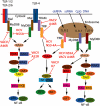Recent insights into the role of Toll-like receptors in viral infection
- PMID: 20560984
- PMCID: PMC2962956
- DOI: 10.1111/j.1365-2249.2010.04196.x
Recent insights into the role of Toll-like receptors in viral infection
Abstract
Toll-like receptors (TLRs) have a central role in innate immunity as they detect conserved pathogen-associated molecular patterns (PAMPs) on a range of microbes, including viruses, leading to innate immune activation and orchestration of the adaptive immune response. To date, a large number of viruses have been shown to trigger innate immunity via TLRs, suggesting that these receptors are likely to be important in the outcome to viral infection. This suggestion is supported by the observation that many viruses have evolved mechanisms not only to evade the innate immune system, but also to subvert it for the benefit of the virus. In this review we will discuss earlier evidence, mainly from knock-out mice studies, implicating TLRs in the innate immune response to viruses, in light of more recent clinical data demonstrating that TLRs are important for anti-viral immunity in humans.
© 2010 British Society for Immunology.
Figures

Similar articles
-
Contemplating the Importance of Toll-like Receptors I and II Regarding Human Viral Pathogenesis.Jundishapur J Microbiol. 2014 Dec 6;8(1):e13348. doi: 10.5812/jjm.13348. eCollection 2015 Jan. Jundishapur J Microbiol. 2014. PMID: 25763131 Free PMC article.
-
Toll-like receptors: key players in antiviral immunity.Curr Opin Virol. 2011 Dec;1(6):447-54. doi: 10.1016/j.coviro.2011.10.006. Epub 2011 Oct 28. Curr Opin Virol. 2011. PMID: 22440908 Free PMC article. Review.
-
Translational mini-review series on Toll-like receptors: recent advances in understanding the role of Toll-like receptors in anti-viral immunity.Clin Exp Immunol. 2007 Feb;147(2):217-26. doi: 10.1111/j.1365-2249.2006.03301.x. Clin Exp Immunol. 2007. PMID: 17223961 Free PMC article. Review.
-
The battle between virus and host: modulation of Toll-like receptor signaling pathways by virus infection.Mediators Inflamm. 2010;2010:184328. doi: 10.1155/2010/184328. Epub 2010 Jun 16. Mediators Inflamm. 2010. PMID: 20672047 Free PMC article. Review.
-
[Innate immune recognition of viral infection].Uirusu. 2006 Jun;56(1):1-8. doi: 10.2222/jsv.56.1. Uirusu. 2006. PMID: 17038806 Review. Japanese.
Cited by
-
Serum of COVID-19 patients changes neuroinflammation and mitochondrial homeostasis markers in hippocampus of aged rats.J Neurovirol. 2023 Oct;29(5):577-587. doi: 10.1007/s13365-023-01156-w. Epub 2023 Jul 27. J Neurovirol. 2023. PMID: 37501054
-
The effect of anesthetics on toll like receptor 9.FASEB J. 2020 Nov;34(11):14645-14654. doi: 10.1096/fj.202000791RR. Epub 2020 Sep 9. FASEB J. 2020. PMID: 32901993 Free PMC article.
-
Innate Sensing of DNA Virus Genomes.Annu Rev Virol. 2018 Sep 29;5(1):341-362. doi: 10.1146/annurev-virology-092917-043244. Annu Rev Virol. 2018. PMID: 30265633 Free PMC article. Review.
-
Interferon-based agents for current and future viral respiratory infections: A scoping literature review of human studies.PLOS Glob Public Health. 2022 Apr 6;2(4):e0000231. doi: 10.1371/journal.pgph.0000231. eCollection 2022. PLOS Glob Public Health. 2022. PMID: 36962150 Free PMC article.
-
Toll-like Receptor Response to Hepatitis C Virus Infection: A Recent Overview.Int J Mol Sci. 2022 May 13;23(10):5475. doi: 10.3390/ijms23105475. Int J Mol Sci. 2022. PMID: 35628287 Free PMC article. Review.
References
-
- Yanai H, Savitsky D, Tamura T, Taniguchi T. Regulation of the cytosolic DNA-sensing system in innate immunity: a current view. Curr Opin Immunol. 2009;21:17–22. - PubMed
-
- Janeway CA., Jr The immune system evolved to discriminate infectious nonself from noninfectious self. Immunol Today. 1992;13:11–16. - PubMed
-
- Kumar H, Kawai T, Akira S. Toll-like receptors and innate immunity. Biochem Biophys Res Commun. 2009;388:621–5. - PubMed
Publication types
MeSH terms
Substances
LinkOut - more resources
Full Text Sources
Other Literature Sources
Medical

